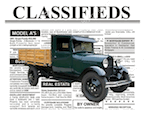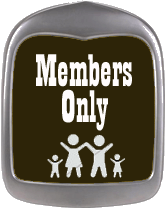Tech Q&A - Chassis - Front End
FRONT AXLE
Question:
I am a new member of MAFCA and I am restoring a 1931 standard coupe (85B) as a driver (hydraulic brakes, etc.) The problem is the front axle is apparently installed backwards so that the spindle locking bolts have to be installed from the rear of the vehicle with the long nuts at the front of the car. The axle is apparently a 1928-29 with small Ford script but has a tapered pinion locking pin. The caster seems OK. The nuts on the bottom of the spring perch have damaged threads and don't want to come off. Is it OK to leave the axle this way. This is not a points car and the spindle locking nuts still keep the wheels from turning too far.
Answer:
The front axle has no front and back side. It can go either way. That is why FORD script is printed on the front right side and left rear side of the axle, no matter which way it is installed. Your problem is that someone has just put the spindle locking bolt in backwards. It can also go in from either side, but should be inserted from the front. Remove the spindle locking bolt and insert it from the front. Be sure to knock the bolt all the way in before applying the nut so as not to strip the threads by forcing the bolt in with the nut. I would suggest leaving the spring perch nut alone if it is still tight. Spring perch bolts are always a problem. They are usually rusted into the axle and can be very difficult to get out. By the way, my answer above assumes you still have a Model A axle and Model A spindles with those hydraulic brakes.
FRONT SPRING
Question:
Our project has become a complete restoration, including complete front end spring removal. When putting the spring back together, we noticed some confusing items:
1. Some springs were slightly narrower.
2. The two largest springs (that stack on top of the main spring) are almost the same length.
3. When mounted on the front axle, the spring eye hits the front spring perch ball. Is this normal when the axle assembly is removed from the frame?
4. Our car appears to be totally original, but we noticed two front springs listed in a part suppliers catalog as a Reversed Eye Spring.
What is the correct spring for our 1928 Sport Coupe (A977082).
Answer:
The main spring (with spring eyes) and the 2nd leaf are close to the same length (2nd leaf about 1/2" shorter on both ends). Each additional leaf should be about 2" shorter on each end. All Model A's had a 10 leaf front spring.
Reversed eye is for dropped front end for Hot Rods. Before placing spring in the car, check spring dimensions for correct arch. Horizontal dimension from center of eye to center of eye is 30-5/8" to 30-13/16". Height at center should be 4-7/8" to 5-1/8" to the bottom of the Main leaf. A weak or collapsed spring will cause the spring eyes to rest on the axle with the weight of the car. With normal car weight, the end of the spring (spring eyes) should be at least 1/4" above the top of the axle. The original spring leaf ends were clipped on the corners. Replacement reproduction springs are square cut on the ends. -- Les Andrews, 1998 Technical Director
FRONT SUSPENSION
Question:
Do I take your comments (below) to mean that 1-1/2 to 2" is the acceptable play in the steering box? Mine has always had that much (maybe just a little more). If so, I'm surprised. I've been looking for something under 1/2". Well, Well, Well.
"Try to adjust the steering box using the procedure in the "Model A Mechanics Handbook". You should be able to adjust it so that you have no more than 1-1/2 to 2" of side-to-side movement measured at the outside circumference of the steering wheel (with wheels straight ahead). If it can't be adjusted up then you will probably need new sector housing bushings and races and bearings.... "
Answer:
Factory spec is 1" free movement with wheel straight ahead ( or steering in center of travel). The amount of free play will increase as the steering wheel is moved right or left from center. This is all designed in to prevent binding. Two inches is acceptable but I would suggest you try adjusting it to
get closer to the 1". To get the 1" you will probably have to make all three adjustments and a rebuild as I described to you earlier. The closer to 1" you get, the better it will handle. Careful with the adjustments. You do not want any binding. -- Les Andrews, 1998 Technical Director
FRONT WHEEL BEARING ADJUSTMENT
Question:
What is the correct adjustment for Front Wheel Bearings?
Answer:
I can tell you that "loose" is better than too tight for the front wheel bearings. You can always tighten a new bearing a little more snug than you can a used bearing. Because of the small diameter of the outer bearing, it is spinning at a very high rpm and have seen many heat and weld itself to the spindle before you can stop the car. You should always replace the bearings and races at the same time. With a new set I snug the axle nut down pretty good then back it off to the first castle position on the nut. If just re tightening the front wheel bearing that has been on the car a while, tighten the axle nut just enough to bring the bearing and race together and then back off to first castle position on the nut. In all cases make sure the wheel spins free. New bearings and races can be a little tighter. They will seat in and loosen some after a few miles. -- Les Andrews, 1998 Technical Director
RADIUS BALL
Question:
In the last issue of Restorer, question arose about radius ball lube felt. I have a question about the new reproduction cap kits: when installed, should there be a gap between the 2 caps? The bottom cap may not be as deeply cut as my worn out original but the ball is firm when the nuts are tightened to the sleeves. The springs are compressed with about 1/16 to 1/8 " gaps. Also, the rubber aftermarket cap kits change the caster a lot.
Answer:
The radius ball cap assembly must be correctly positioned and correctly installed to provide the correct caster alignment at the front axle (5 degrees). If the radius ball is worn or loose in the ball cup, the front end caster cannot be maintained. Likewise, if the ball is held rigid in the ball cup, due to incorrect installation, the radius rods will bend or twist when driving on rough roads or hitting a pot hole in the road. The radius ball must fit snug to the ball cap but be allowed to flex on the mounting bolt springs. The after market rubber ball modification for the radius ball is not advisable. In most cases the front caster will be lost with the mod. kit. If the radius ball is loose in the ball cup, a shim can be made from a fender washer by using a ball peen hammer to shape the washer to fit the bottom curvature of the ball.
-- Lyle Meek, Technical Director
SEALS
Question:
I have discovered something new about this front end which I have. I recently purchased grease seals/ dust seals for this front end (model a part number being A-1190) when I went to install then they would not fit. So I compared the old seal to the new seal and the new seal is about 1/4 smaller. So I am not sure what this front end belong on. Any ideas to what it might go to maybe a later year ford ?
Answer:
Part A1190 is a cupped washer that fits at the base of the spindle. Its purpose is to prevent grease from the wheel bearing from splashing on the brake parts. Its more of a shield than a seal, although it is called a grease seal. It is a press fit at the base of the spindle. Are you sure you have Model A spindles? The spindle attaches to the axle with the king pin. All Model A axles have ford script on the front left side of the axle and on the rear left side of the axle. You may want to compare your spindles with someone else who has a Model A. Axle and spindles were the same from 1928 through 1931. -- Les Andrews, 1998 Technical Director
SPINDLE ARM BALLS
Question:
How much "Out of Round" is acceptable for the spindle arm balls? Did the factory have any recommendation as to when to rework the balls?
Answer:
Any out of roundness will cause a change of position when the wheels are turned. I would say that more than 1/8" out of round would then require rework or replacement of the spindle arm balls. They should be 1/2” round. Many are worn flat on the sides This makes adjustment real difficult. If it doesn't appear to be out of round then don't bother with it. The object is to try to hold a 25% compression of the springs in the end of the tie-rod, while turning the wheel from stop to stop. This will provide the smoothest turning radius and maintain the correct toe-in adjustment. -- Les Andrews, 1998 Technical Director
TIRES HITTING BRAKE RODS
Question:
My tires keep hitting the brake rods. Any ideas why this can be happening?
Answer:
You taught me something this past week. Regarding your question about tires hitting the brake rods. I wasn't completely satisfied with the answer I gave you because it seemed there should be more to it than that. Well there is. There is a STOP for turning travel. On the end of the axle, near where the king pin goes through, there is a locking bolt for the king pin. The nut for the king pin locking bolt is on the back side of the axle. This is a special bolt that is about 1-1/8 inches long. This is the STOP for turning radius. You will see where it hits a dimple on the back side of the spindle. Place a thick lock washer under this nut (extending the length) to adjust tire to brake rod clearance. For 30 years I have been working on Model A's and never associated the length of that locking bolt nut as a turning radius STOP. Thanks for the lesson. -- Les Andrews, 1998 Technical Director
WHEEL BEARINGS
Question: Do you have the number for the front wheel bearing and races? All I have is the Model A part number and the local auto store can't find a match.
Answer: Well, you can order the bearings and races from any of the Model A parts dealers using the Model A part number.
However, here are the Ford numbers AND the Timken numbers:
| Ford | Timken | Description | |
| A-1216 | 09074 | Outer Bearing | |
| A-1217 | 09196 | Outer Race | |
| A-1201 | 15118 | Inner Bearing | |
| A-1202 | 15250X | Inner Race | |
| -- Lyle Meek, 1997 Technical Director | |||
WISHBONE
Question:
Will a loose ball in the front wishbone at the transmission cause a shimmy? I have heard arguments in both directions. We have placed new everything in this car and it still shimmies.
Answer:
A loose ball in the front wishbone can be one of the causes of front shimmy. The front end caster ( 5 degrees) is dependent on the exact position of the front radius ball. Make sure you have all the correct pieces to mount the radius ball to the bottom of the flywheel housing. It should consist of an upper and lower cap, two spacers that fit through the mounting holes in the lower cap, two springs and two castle nuts. If the assembly is correct and the ball does not fit tight, make a shim out of a thin fender washer, pounded to fit around the top half of the radius ball and reinstall the cap assembly. Then measure the front end caster. Also make sure the tie rod ends and the drag link ends are screwed in tight enough. Screw the ends in one full turn past contact with the spindle arm balls. Toe-in should be 1/16" to 1/8". Also make sure the mounting bolts for the steering gear box are very tight. I assume you have already replaced the king pin bushings. All these things relate to front end shimmy. The most over looked and cause is incorrect front end caster adjustment. This is determined by the position of the radius rod ball.





